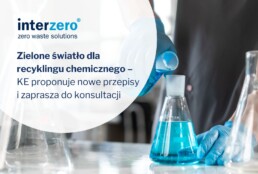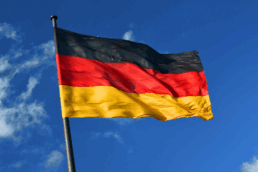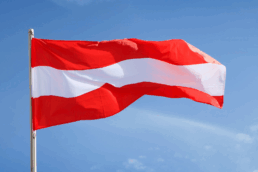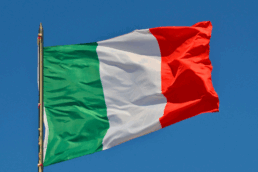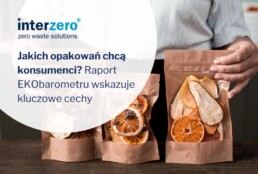There will be a ROP for textiles. European Parliament in favour of revision of the waste directive
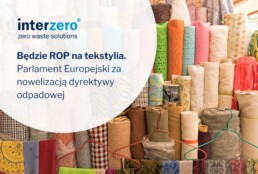
Newsletter
Extended liability for textile producers getting closer
Soon, all businesses placing textiles and footwear on the EU market will be obliged to bear the costs of collecting them separately, sorting them, preparing them for re-use and recycling them. Adopted by the European Parliament the revision of Waste Directive 2008/98/EC will introduce an obligation to establish a Community-wide ROP system for textiles.
The content of the act had been agreed with the EU Council a few months earlier. Both legislative bodies will have to sign off the new directive before it is published in the Official Journal of the European Union. From the date of entry into force of the new legislation, Member States will have 20 months to transpose it and an additional 10 months (i.e. a total of 2.5 years) to put the ROP systems in place for textiles.
Under the terms of the amendment, companies bringing in textiles and footwear will bear the costs of separate collection, sorting, preparing for reuse and recycling of textile and footwear waste. As EU projections indicate, the majority of financial contributions from producers will go towards waste prevention and preparing for re-use.
Who will be covered by the ROP for textiles? Personal scope of extended producer responsibility
The obligations arising from the ROP will include all manufacturers of textile products, products incorporating textile materials and footwear products. In the absence of previous regulations, the amendment to the Waste Directive will introduce a definition of such a producer.
Any manufacturer, importer, distributor or other natural or legal person who:
- manufactures textiles or footwear under its own name,
- commissions the design or manufacture of textiles or footwear and markets them under its own name,
- resells textiles or footwear manufactured by another entity and not bearing a name or trademark,
- sells textiles and footwear directly to end users through distance contracts.
The Directive allows Member States to set up ROP systems also with regard to mattresses. However, the following will be excluded from the ROP obligations: self-employed tailors producing customised textiles, introducing second-hand, repaired, upcycled textiles, etc., and producers of textile products made from textile waste.
New responsibilities and new players - ROP for textiles will create space for new producer responsibility organisations to operate
Producers covered by the textile ROP scheme will be able to fulfil their obligations through a producer responsibility organisation. The revision of the Waste Directive allows for multiple organisations (also state-owned) in a single Member State.
The preamble of the amendment clearly states:
"Member States are encouraged to consider allowing multiple producer responsibility organisations as competition between them can benefit consumers, increase innovation, reduce costs, improve the separate collection of textiles and provide producers with a greater choice of operators with whom to contract."
The main task of the producer responsibility organisation will be to setting up textile waste collection and management systems. The amendment defines this activity as:
organising financially or financially and operationally the fulfilment of extended producer responsibility obligations.
In addition organisations will be able to take over the information obligations imposed on textile producers, which include the provision of information and information campaigns on sustainable consumption, waste prevention, reuse, preparation for reuse, including repair, recycling, other recovery and disposal of textile and footwear waste. Thus, it appears that the ROP will solve numerous problems for municipalities and their residents related to mandatory separate collection of textiles.
Importantly, producers or organisations will not have to reach the collection, preparation for re-use or recycling percentagesThe amendment stipulates that by the end of 2029, the European Commission may set targets for the prevention, collection, preparation for re-use and recycling of textile waste.
See also: Contemporary challenges in textile recycling - an interview with Barbara Kądziela from WWF Poland >>
Ecomodulation of charges in the ROP for textiles
The proposed ROP scheme provides for the introduction of eco-modulation of charges, which will give preference to manufacturers producing high quality textiles. Fees are to be modulated according to a product's environmental impact, recyclability, durability, presence of hazardous substances and recycled content.
The detailed criteria for setting product charge rates for textiles will be specified in Commission implementing acts. However, it is known that they will be adapted to the product category and the state of the art. As noted in the EP press release, When setting the level of charges, Member States should also take into account the phenomena of fast fashion and ultra fast fashion.
Producers will pay the ROP fees to producer responsibility organisations operating in the Member State into which the producer introduces its textiles. As the EU points out, this is because it is in that country that textile products are likely to become waste. At the same time, the directive implies the creation of mechanisms to prevent the charging of fees for textiles for which the producer has already paid fees in another Member State.
Why textiles? Motives for establishing a ROP scheme for textiles and footwear
In the preamble to the amendment the textile sector has been identified as one of the most resource-intensive with negative environmental impacts. EU authorities have also pointed out that companies in the sector often fail to comply with waste management rules and the waste hierarchy, which puts waste prevention first.
Read also: Polish fashion e-commerce drowns in plastic bag waste >>
Currently most textiles are not designed with recycling and circularity in mind, and as much as 78% requires separation of raw materials before processing. As a result less than 1% of the 12.6 million tonnes of clothing waste is recycled generated each year in the EU. The aim of the amendment is to create an economy based on collection, sorting, reuse, preparation for reuse and recycling, in particular fibre-to-fibre recycling. fiber-to-fiber), as well as encouraging manufacturers to design textiles and footwear in line with circularity principles.
Sources:
- Parliament adopts new EU rules to reduce food and textile waste, https://www.europarl.europa.eu/news/pl/press-room/20250905IPR30172/parlament-przyjmuje-przepisy-ue-o-ograniczeniu-marnowania-zywnosci-i-tekstyliow
- Content of the Directive adopted: https://data.consilium.europa.eu/doc/document/ST-6978-2025-REV-2/pl/pdf
Green light for chemical recycling - EC proposes new rules and invites consultation
Yes to chemical recycling in PET plastic bottles
The draft proposed by the Commission for the first time allows raw material treated by chemical recycling methods to be counted to meet the ambitious targets set by the SUP Directive. Its provisions oblige producers to use recyclates in PET bottles - from 2025 their content must be min. 25%, and from 2030. - 30%.
The new regulations aim to complement the current methodology for calculating the recyclate content of mechanical recycling. Due to its lower environmental impact and energy consumption mechanical recycling will continue to be the preferred treatment technology for plastics waste. Chemical recycling, on the other hand, will find application in situations where mechanical methods cannot be used or where a higher level of purity is required - such as for food packaging.
New methodology for calculating recyclate content
According to the draft, the share of recycled plastics in SUP bottles is to be counted as the ratio of the weight of the recyclate to the weight of all the plastic parts of the bottle placed on the market in the Member State concerned. This means that to the weight of beverage packaging introduced will include not only the bottles themselves, but also their caps and labels (traditional and sleeve type). Provision is also made for data correction in the case of import, export or movement between EU countries.
Entrepreneurs will additionally be obliged to report the weight of plastic packaging and the share of recyclate in the different parts of the bottles on the basis of the declaration of conformity. Verification will take place on an annual basis (or every three years for SMEs) and responsibility for data compliance will rest with the entrepreneurs and the national control authorities.
The "no fuel use" principle
The new methodology for calculating the chemical recycled content of PET bottles is based on the principle of 'fuel-use exclusion'. This means that waste treated for fuel production or energy recovery must not be added to the recycling balance. Only those fractions that have actually been turned into new recyclables will be counted.
It should be recalled that chemical recycling technologies make it possible to convert plastics not only into new plastics, but also into fuel (e.g. pyrolysis, gasification). Find out more about chemical recycling methods and technologies >>
Changes for investment and increased competitiveness
The establishment of clear criteria and unambiguous definitions is intended to create a a level playing field for all players in the EU market and ensure greater legal certainty and stability for investors. We are, of course, referring to investments in new chemical recycling plants and technologies, which have so far been held back due to a lack of sufficient regulation. The proposed legislation is part of a broader action plan for the EU chemical industry, which aims to increase the competitiveness of the sector and its sustainable transformation. They also provide opportunities for the wider use of recycled chemical plastics and the development of the industry across the EU.
The Commission further points out that the development of a common methodology is important to further reduce landfilling and incineration of plastic waste and the promotion of a circular economy.
Restriction - EU recyclate only until new legislation is adopted
In parallel with the launch of the public consultation, the Commission confirmed the existing interpretation of the SUP Directive - from 2025 to meet the 25% target of rPET content in PET bottles only material derived from waste collected in the EU may be included. In practice, this means that cheap PET recyclate imported from Asian countries, among others, will not be included in the calculation.
The EC's interpretation will be binding until the new rules come into force, which are intended to allow imported raw material to be included, provided that EU environmental and quality standards for waste collection and treatment are met.
Growing importance of chemical recycling as an answer to the waste crisis
In an era of ever-increasing waste generation, The EU wants to support all technologies that return raw materials into circulationand at the same time are more beneficial to the environment than incineration and landfilling. In the wave of this trend Interzero and OMV join forces to create Europe's largest sorting plant for raw materials for chemical recycling. The start-up of the plant in Walldürn, Baden-Württemberg, is planned for 2026.
The new reporting and calculation system is intended to provide transparency throughout the value chain, especially in its most complex stages. The proposed methodology is intended to serve as a model for future regulations on the share of recycled materials in other sectors - such as packaging, automotive or textiles - as well.
Public consultation
Comments on the draft implementing act could be sent until 19 August 2025. The adoption of the act is likely to take place later in the autumn of 2025.
Delays in implementing GOZ in Poland - NIK report reveals reasons
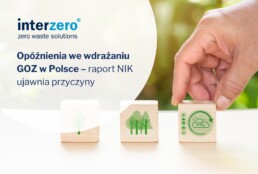
Newsletter
Transformation towards GOZ correct, but not fully effective
In its report, the NIK assessed the degree of implementation of the circular economy, taking as a benchmark the data and activities planned in the Roadmap for the transition towards a circular economy, adopted by the Polish government in September 2019. The NIK analysis, however, covered the period from 2018 to 2022.
In the opinion of the Supreme Audit Office:
- Action by state and local authorities have contributed to the fundamental objectives of contained in The GOZ roadmap.
- Due to insufficient cooperation between ministries and the lack of coordination and monitoring of activities by the Minister of Development and Technology, activities were not fully effective or timely.
- Of the 41 planned actions by the end of November 2023, only 28 had been completed. The remaining 13 actions had not been implemented, including four that had not even started.
What's more, Map was not properly updated. The original plan covered the period 2021-2023, after which it ceased to be a valid government document.
Delays in the implementation of EU law and a decline in the circularity index the main allegations in the NIK report
The main reasons for delays in the implementation of GOZ, the NIK report sees, among other things, in the untimely implementation of EU environmental legislation. These include 3 key directives from the point of view of the country's waste management:
- Waste Directive 2008/98/EC (as amended by Directive 2018/851),
- Packaging Directive 94/62/EC (as amended by Directive 2018/852),
- plastic directive (SUP) 2019/904.
To date, we have not seen the full transposition of the aforementioned acts - the law on ROP is only in the early stages of the legislative path, and the SUP regulations require several key amendments, which the EC called on Poland to implement in June 2025.
The introduction to the NIK report also includes information on a decrease in the circularity index of the Polish economy from 10.5% in 2018 to 7.5% in 2023. Over the same period, the EU indicator remained stable at 11.6% in 2018 and 11.8% in 2023. Reasons cited as reasons for this include. significant decrease in the use of recycled materials (from 76 million tonnes in 2018 to 46 million tonnes in 2023), the lack of full transposition of EU environmental legislation and the failure to accelerate the process of successive elimination of waste with adverse environmental impact. As a consequence, Poland has not met the EU targets for GOZ implementation.
Local authorities' actions are correct, but tangible results are lacking
The NIK audit took place not only at government level, but also at local government level. No major irregularities were found in the 8 municipalities visited - local authorities have been active in implementing GOZ by fulfilling the obligations imposed on them by legislation, mainly in the field of municipal waste management. Despite this in 4 of these municipalities the required level of preparation for re-use and recycling was not achievedand most of them were dominated by forms of municipal waste management less favourable from the point of view of the GOZ: landfilling and incineration.
The NIK report also reveals that the area of municipal waste management at municipal level requires financial support from the state. It is currently in deficit in most municipalities.
The local problems were also reflected in the waste management of the country as a whole, with Poland failing to achieve the minimum recycling and PDPU (Prepare for Reuse) levels for paper, metal, plastic and glass waste between 2020 and 2022. NIK also points out that there is a high risk of not achieving the target minimum in subsequent years. What's more, it is becoming increasingly real that the EU's required maximum landfill rate for municipal waste will not be met.
9 billion tax on plastic - costly lack of plastic recycling
Failure to meet EU targets for recycling, preparation for re-use and landfilling of municipal waste may give rise to penalties imposed by the CJEU in the future. NIK also points out that Poland's realistically achieved recycling levels may be lower than shown. This is all due to the poor quality of the data collected and obtained from the BDO, which form the basis of the calculations.
Poland is already paying high fees from the so-called plastic tax calculated on the weight of plastic packaging waste that has not been recycled. According to the Ministry of Finance, between 2021 and 2024, Poland paid around PLN 9 billion to the EU budget from the plastic tax.
What does the EU review of environmental policy implementation 2025 say about this?
The publication of the NIK report coincided with the release of the results of the fourth review of the implementation of environmental policy (EIR) in EU Member States. The most important event for Poland was identified as a significant reduction in the use of plastic bags for purchases per capita. This rate fell from 23 units per capita per year in 2019 to 6.6 units in 2022.
The review highlighted that since joining the Community, Poland has made significant progress in environmental protection. However, our country still faces many challenges, the key ones being the improvement of air quality and the gradual implementation of GOZ.
- The current air quality raises a number of issues and concerns, mainly due to exceedances of the limit values for NO2 and PM10 concentrations and the target values for ozone, arsenic and benzo(a)pyrene.
- Poland is at risk of failing to meet the targets set out in the Framework Directive, i.e. 55% PDPU and municipal waste recycling and 65% packaging waste recycling.
European Commission intensifies action to support transition to GOZ
2 July 2025. The European Commission has announced the launch of a series of initiatives to accelerate the European Union's transition to the GOZ. These are a prelude to the development of a circular economy act, scheduled for adoption in 2026, the Commission said in its communication:
The future act will support the EU's goals under the Competitiveness Compass and Clean Industrial Order to double the share of recycled materials in the EU economy by 2030 and become a global leader in the circular economy.
The new package of activities includes:
- digitisation of the EU waste shipment system - going completely paperless from 21 May 2026,
- Consultation on the harmonisation of the classification of the so-called green list of waste,
- an evaluation of the WEEE Directive on waste electrical and electronic equipment and the gaps in collection and recycling of electro-waste that were perceived after the introduction of the Directive.
Sources:
- NIK, Implementing the circular economy. Information on the results of the audit, https://www.nik.gov.pl/plik/id,30907,vp,33980.pdf
- Review of the implementation of the Environmental Policy 2025, https://op.europa.eu/webpub/env/eir-country-reports-summaries/en/poland.html
- Key actions initiated to develop a circular economy, https://ec.europa.eu/commission/presscorner/detail/pl/ip_25_1710
Almost 180 million from plastic bags. Where will the money from the recycling levy go?
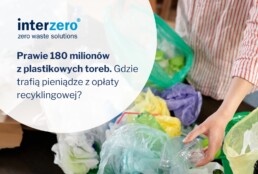
Newsletter
Nearly £180 million in revenue from the recycling fee
The Ministry of Climate and Environment has announced the amount of revenue from the recycling levy for 2024, amounting to nearly £178.7 million, 6 million more than in 2023. The Ministry of Climate and Environment estimates that the total revenue from the recycling levy for 2025 should remain at the same level as for 2024.
As a reminder, the recycling fee covers almost all plastic shopping bags with the exception of so-called rip-offs - very light bags of less than 15 micrometres thickness used for hygiene purposes. As of 2018, the rate of the recycling fee is invariably PLN 0.20 + VAT for each bag issued to a customer.
Find out more about the recycling levy for commercials >>
What is the recycling levy used for?
The mandatory recycling fee was introduced on 1 January 2018. Initially, it only applied to plastic bags up to 50 microns thick. As of 1 September 2019, the legislation was sealed and the recycling fee was extended to other bags with a material thickness of 50 microns and above. Currently, the recycling fee is settled quarterly and paid into an account held by the provincial marshal.
Revenues from the recycling levy in 99% constitute revenue for the state budget and in 1% for the budget of the provincial government. This 1% of the proceeds is used to cover the costs of enforcement of the recycling fee and the additional recycling fee and the administrative operation of the system for collecting these fees. The remaining amount is transferred by the provincial marshal to the state budget.
Recycling levy as a way to shape consumer behaviour
According to the climate and environment ministry, the introduction of a recycling levy encouraged consumers to use alternative bags. Just before the mandatory levy was implemented, the ministry estimated the average annual consumption of all types of plastic bags at 300 bags per capita. Based on data on the amount of the recycling levy paid, the ministry calculated that this consumption had fallen to, respectively:
- 9 units per person per year in 2018,
- 3.7 units per person per year in 2019,
- 5.2 units per person per year in 2020,
- 5.3 units per person per year in 2021,
- 5.5 units per person per year in 2022,
- 6.1 units per person per year in 2023.
However, it is worth remembering that these statistics relate only to bags with a material thickness of more than 15 micrometres. The scale of use of all plastic bags is difficult to estimate. According to IOŚ-PIB data, in the whole of 2022, Polish retailers issued 865,280,860 plastic bags to their customers, of which 3.9% were very light bags (so-called rip-offs), 24% light bags with a material thickness of 15 to 49 micrometres, and 72.1% other bags with a material thickness of 50 micrometres or more[i].
[i] IOŚ-PIB, Packaging and packaging waste management in Poland in 2022., https://ios.edu.pl/wp-content/uploads/2024/09/gospodarka-opakowaniami-i-odpadami-opakowaniowymi-w-polsce-w-2022-r-2.pdf
Still other data can be found in the latest review of environmental policy implementation:
Poland has managed to achieve a noticeable reduction in plastic shopping bag consumption per capita - from 23 in 2019 to 6.6 in 2022, the second best rate in the EU.
First data on the charge for disposable cups and takeaway food packaging (SUP)
2024 was the first year in which businesses charged for single-use plastic food and beverage packaging. SUP charge rates were set at:
- £0.20 for drinks cups,
- £0.25 for food packaging.
The Ministry of Climate and Environment informed via PAP that approximately PLN 156.6 million was received by the National Fund for Environmental Protection and Water Management from charges for disposable cups and food packaging in 2025. Almost ¼ of the total sum (PLN 40 million) came from entrepreneurs from the Mazowieckie Voivodeship.
The ministry is withholding estimates for the SUP levy revenue in future years for the time being. It argues that this is a new levy and no conclusions can be drawn on the basis of the data currently available.
Do fees encourage people to be eco? The answer can be found in Interzero report In the traps of disposability >>
Global warming accelerates - Earth's average temperature will rise by 1.5 degrees C in three years' time
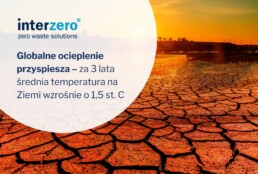
Newsletter
CO2 emissions up, carbon budget down
An annual update of key climate system indicators has revealed that in just three years the Earth's average temperature could rise by 1.5 degrees C compared to the pre-industrial era. As scientists point out, the main reason for this is the ever-increasing emissions of CO2, methane and other greenhouse gases.
In 2020, scientists calculated that humanity could emit a maximum of 500 billion more tonnes of CO2 to maintain at least a 50% chance of stopping global warming below 1.5 degrees C. The then defined "carbon budget" in 2025. has shrunk to just 130 billion tonnes of CO2. In developing the latest findings, the researchers used an improved method of calculating key indicators, which further revealed the scale of the problem. With global emissions of around 40 billion tonnes of CO2, So we have about 3 years left until this "budget" is exhausted and to exceed the symbolic threshold of 1.5 degrees C.
According to one of the report's lead authors, Professor Piers Forster, Director of the Priestley Centre for Climate Futures at the University of Leeds, "Everything is going in the wrong direction". Every year, scientists note an increase in emissions from fossil fuel combustion, industrial activities, land cultivation and deforestation.
"We are seeing some unprecedented changes, and we are seeing that the warming of the Earth and the rise in sea levels are also accelerating. [...] These changes have been predicted for some time and we can directly transfer them to very high levels of emissions", Forster added.
At the same time, the report's authors emphasise that rapid and decisive emissions reductions (such as those pledged at COP28 at the end of 2023) could slow the rate of increase in global average temperatures by up to half over the next 20 years.
Learn about Interzero's contribution to climate and resource conservation >>
The Paris Agreement is not working - the Earth's average temperature has exceeded its target level
Across the globe, attempts have been made for years to reduce emissions and associated global warming. In 2015, under the Paris Agreement 195 countries of the world have committed to develop long-term action plans to reduce greenhouse gas emissions in such a way as to limit global warming to less than 2 degrees Celsius, with a target of 1.5 degrees Celsius relative to the pre-industrial era. Less than 10 years later, in 2024, global average temperatures were recorded for the first time to exceed the assumed 1.5 degree increase relative to the late 19th century.However, scientists emphasise that one year of overruns does not yet mean a breach of the Paris Agreement. They point out, however, that human activity was the main cause of the high temperatures last year.
"Temperatures have been rising year on year since the last IPCC report in 2021, showing that climate policy and the pace of climate action have not kept pace with what is needed to curb the ever-increasing impacts of the" - Professor Foster pointed out - ".Continued record high greenhouse gas emissions mean that more and more of us are experiencing dangerous levels of climate change impacts."
The climate is currently warming at a rate of around 0.27 degrees C per decade. Between 2015 and 2024, the rate of warming was more than double that of the 1970s and 1980s and an estimated 25% higher than in the late 2000s and 2010. Without significant emission reductions, around 2030, we will exceed the Paris Agreement ceiling of 1.5 degrees C. The next threshold, 1.6 or 1.7 degrees C, on the other hand, could be exceeded in the next nine years.
Read also: Net zero at risk - will the EU achieve climate neutrality by 2050?
Combating the effects of climate change drains the Polish budget
The effects of global warming are already taking their toll on the Polish taxpayer. The IOŚ-PIB has estimated that due to extreme weather events, every year Poland loses around 6 billion PLN. Cumulative losses for the period 2001-2019 amounted to as much as PLN 119 billion. Particularly severe for Poland are prolonged droughts, the frequency of which in 2010-2019 increased by as much as double compared to previous decades. This is followed by river floods, storms and intense rainfall, heat waves and tornadoes.
From 2050 onwards, climate change could cost Poland up to PLN 124 billion a year, equivalent to 2.2% GDP. This will happen if Europe and the world slow down the green transition towards low-carbon economies. With consistent implementation of the climate targets set there is an opportunity to reduce annual expenditure to 1.5% GDP, or 84 billion PLN. Current public spending on climate and air protection, on the other hand, amounts to... 0.2% GDP. As the report's authors report, this is more than 2 times less than fossil fuel subsidies and more than 3 times less than budget revenues from the sale of emission allowances.
"We are already suffering the real losses of progressive climate change, although in the public debate we often still treat it as a topic of the future" - says Alexander Sniegocki, co-author of the report The costs of climate change in Poland. Why does Poland need an active climate policy?, president of the Reform Institute and head of economic analysis. "Without investment in resilience and adaptation, Poland will not only be poorer, but also less safe and increasingly helpless against the effects of avoidable phenomena.".
International Court of Justice will examine states' climate protection obligations
From the above paragraphs and the scientific statements quoted, one can conclude that countries are still not making adequate efforts to combat climate change. Steadily rising emissions and global temperatures, as well as insufficient investment in pro-climate measures, clearly suggest that the current and future state of the environment is not a priority for those in power. However, this may soon change - The International Court of Justice is currently working on an advisory opinion that will set out the climate protection responsibilities of states and the consequences of not fulfilling these obligations.
The ICJ began proceedings in March 2023 at the request of the UN General Assembly. The issue of clarifying the obligations of states was raised by Vanuatu, which could be very affected by changes related to global warming. While the ICJ's opinion will not be binding on UN states, the can significantly influence the future direction of their climate policies. If the ICJ decides that tackling global warming and reducing emissions are the legal obligations of states, the will provide activists, NGOs and lawyers with strong arguments in legal processes against countries, companies and lobbyists, among others. Such an opinion can be a turning point in global climate policy, setting new legal standards and becoming one of the bases for judgments by national courts. Indeed, ICJ opinions are interpretations of international law, including human rights, which are inviolable and inalienable.
The Court is currently accepting positions submitted by States, the UN and NGOs. Due to the vast amount of material to be analysed, An opinion is not expected until the end of 2025 at the earliest.
Sources:
- M. Foster et al, Indicators of Global Climate Change 2024: annual update of key indicators of the state of the climate system and human influence, https://essd.copernicus.org/articles/17/2641/2025/
- Poynting, Three years left to limit warming to 1.5C, leading scientists warn, https://www.bbc.com/news/articles/cn4l927dj5zo
- Scientists find three years left of remaining carbon budget for 1.5°C, https://climate.leeds.ac.uk/news/scientists-find-three-years-left-of-remaining-carbon-budget-for-1-5c/
- New report: Poland is paying billions for the effects of climate change - and will pay more and more, https://www.clientearth.pl/najnowsze-dzialania/artykuly/nowy-raport-polska-placi-miliardy-za-skutki-zmiany-klimatu-i-bedzie-placic-coraz-wiecej/
- Stefańczyk, A. Śniegocki, M. Wojtyło, Climate change costs in Poland. Why Poland needs an active climate policy, https://www.clientearth.pl/media/hljdm1s3/koszty-zmiany-klimatu-w-polsce.pdf.
- Can the UN force countries to do more to tackle climate change?, https://www.f5.pl/zmiany-klimatu/czy-onz-moze-zmusic-kraje-do-wiekszych-wysilkow-na-rzecz-przeciwdzialania-zmianom-klimatu
Government implements EU battery regulation. We know the assumptions of the draft law
The battery regulation has entered into force, we are still waiting for the Polish law
Regulation (EU) 2023/1542 of the European Parliament and of the Council of 12 July 2023 on batteries and waste batteries entered into force on 24 February 2025. The new regulation broadens the information obligations of producers towards consumers, obliges specific labelling of batteries and emphasises recycling and circularity.
The battery regulation obliges battery manufacturers to, among other things:
- implementation of due diligence procedures in supply chains,
- labelling and marking of batteries,
- the use of recycled materials to manufacture new batteries,
- to produce a carbon footprint declaration for the batteries produced,
- ensure the separate collection and treatment of batteries,
- achieving the collection rates for portable and LTM batteries set out in the regulation,
- accepting waste batteries from end-users free of charge.
Most of these obligations come into force on 18 August 2025. As the deadline for the implementation of the regulations approaches, the Ministry of Climate and Environment has drafted the assumptions of the Battery Act, which has been published in the Government's legislative work list (project number UC107). The draft law is intended to ensure the effective application of the regulation's provisions in Poland. The current Act of 4 April 2009 on batteries and accumulators will be repealed in its entirety.
There will be a Polish ROP for batteries and new BDO functionalities
One of the key objectives of the Polish law is introduction of an obligation for battery producers to conclude a contract with a producer responsibility organisation (PRO Producer Responsibility Organisation). This is particularly important in the context of the large number of importers from outside the European Union - the new rules are intended to counter the phenomenon of 'free riders', i.e. companies avoiding environmental obligations.
The national act will also provide a legal framework for the operation of producer responsibility organisations, including a procedure for authorising the fulfilment of extended producer responsibility obligations for batteries. The liability organisation will be required to conclude agreements with collectors and waste battery treatment facilities. Its activities will not only be monitored by the relevant authorities, but will also be subject to a mandatory external audit at least every three years.
The Battery Regulation requires Member States to designate one or more bodies to fulfil extended producer responsibility obligations and to establish a register of battery producers. In Poland, this register will be the BDO already in place, which will include information on the types of batteries first made available by a producer on the Polish market and how it complies with its ROP obligations.
Obligation to appoint an authorised representative for foreign introducers
Under the Battery Ordinance all manufacturers selling batteries to end-users from other Member States and by means of distance communication are obliged to designate authorised representative for ROP in each of these Member States. This obligation derives directly from the Regulation and will be applied directly as early as 18 August 2025. It applies to introducers of all types of batteries, including those built into appliances, light transport or other vehicles.
Product fee for batteries and accumulators under new rules
According to the IEA's plans, the draft Battery Act will clarify the rules for collecting, storing and processing used batteries, including those used in electric vehicles and industrial installations. It will also specify the rules for calculating and paying the product levy for a battery that will be imposed on producers failing to meet minimum collection rates. We can also expect an update of the current product fee rates for batteries - the new Battery Act will set a minimum and maximum rate for this fee, and the actual rates for waste portable batteries and waste LMT batteries will be set in an implementing act issued on the basis of statutory delegation.
A deposit fee charged to customers when they purchase SLI batteries will also be introduced, with the obligation to return it after the used cell has been returned. The unclaimed deposit fee will go into a special account of the provincial marshal.
Authorised representative of the manufacturer - who is he and who must appoint him?
Newsletter
EU rules impose an increasing number of obligations on businesses in relation to extended producer responsibility. One of these is the need to appoint an authorised representative in individual Community markets. As the Interzero Group, we offer this service to all companies operating within the EU. However, before get to know our offer, check what you need to know about the manufacturer's authorised or authorised representative.
Who is an authorised representative and what is their role?
An authorised representative is a natural or legal person established on the territory of an EU Member State who is a representative of a foreign manufacturer (manufacturer, introducer) in the Member State concerned. Authorised representative shall act under the written authority of granted to it by the manufacturer and fulfils the obligations relating to the placing of goods on the market in the Member State concerned (ensures that products comply with EU requirements, provides information and documentation on product compliance on request of authorities, cooperates with supervisory authorities on conformity assessment, inspection and enforcement, ...). These obligations may arise, for example, from local extended producer responsibility legislation or from legislation issued in implementation of the SUP Directive and the PPWR Regulation.
Example 1: Company X is based solely in Poland. It has recently started selling its products to customers in the Czech Republic, Slovakia and Hungary - it is therefore perceived as a foreign manufacturer in these markets and is entitled to appoint an authorised representative, e.g. for extended producer responsibility.
Who is required to appoint an authorised representative?
Both EU legislation and national regulations in many Member States oblige certain manufacturers to appoint a local authorised representative. This usually applies to companies that are not established in the Member State concerned and sell their goods (mainly packaging, batteries, electrical equipment) to individual customers located in that country by means of distance communication. Failure to appoint an authorised representative when required may result in fines. An authorised representative can be a natural or legal person established in the EU.
Example 1: Electronics retailer Company A is based in Poland, but also sells its products to individual customers in Germany and Austria. For this purpose, it uses its own online shop and several sales platforms. Company A does not need an authorised representative in Poland - it is established in the country and can fulfil its obligations as an introducer on its own. However, it needs to establish an authorised representative for EPR in Germany and Austria - otherwise it will not be able to legally sell its goods to foreign customers.
Example 2: Polish Company B manufactures small domestic appliances in its own factory, which it then sells to electronics wholesalers in Spain, Portugal and Greece. Company B only operates in the B2B sector, so it does not need to appoint an authorised representative in any of these markets. Importantly, at the same time, it has the right to appoint an authorised representative in each country, which it can exercise at any time.
Example 3: Chinese company Z sells packaged products via online platforms Temu and AliExpress. Its customers are mainly individuals residing in EU countries. Company Z will therefore need to appoint an authorised representative for EPR and PPWR in all Member States where its customers are located and where regulations are already in place.
Check your packaging licensing obligations in EU countries
Why was the need to appoint an authorised representative introduced?
The aim was primarily ensuring compliance with national and EU law. In this way each EU Member State has gained the ability to enforce obligations on traders placing goods on its market. Foreign traders can no longer evade their environmental obligations without any consequences or hide behind ignorance of local law - if they want to sell directly to consumers, they must appoint (usually for a fee) a representative to take care of cyclical reporting, payment of environmental fees, management of waste from the goods introduced, etc.
The need to appoint an authorised representative is also beneficial in terms of:
- Environmental - the foreign manufacturer must take extended responsibility for the products introduced and bring them into line with local regulations (e.g. SUP, PPWR); this reduces the amount of waste generated and ensure the proper management of waste already generated,
- competitive - all traders offering their goods to customers must comply with identical legal obligations and bear the resulting costs. The risk of placing goods on the market at an undervalued price due, for example, to their failure to comply with restrictive European regulations and the manufacturer's failure to pay all the required environmental fees disappears,
- consumer - the consumer (individual consumer) is assured that all the services offered to him/her the products comply with local regulationsand their manufacturer (importer, intra-Community supplier) will take care of the subsequent management of the resulting waste.
Authorised or authorised representative? What is the difference?
None. The concept of an 'authorised representative' is more frequently encountered in EU legislation and the institution of an 'authorised representative' in Polish legislative acts (however, this is not an absolute rule). In principle, The two institutions are the same and differ only in name.
It doesn't matter whether your company has to appoint an authorized or authorised representative - in any case it is a local representative who will fulfil your specific legal obligations in relation to various goodswhich you market in the Member State concerned.
Authorised manufacturer's representative for PPWR
PPWR Regulation obliges certain companies to appoint an authorised producer representative in each Member State in which they are not established and into which they introduce packaging or packaged products. This obligation covers manufacturers, importers or distributors established in a Member State or in a third country and making available for the first time on the territory of another Member State, directly to end users:
- packaging transport packaging, service packaging or packaging for primary production (disposable or reusable),
- packaged products other than those mentioned above.
Other manufacturers have the right to appoint an authorised representative in the EU markets into which they place their packaging and packaged products. In this way these generators can delegate their time-consuming and knowledge-intensive responsibilities to a professional local entity.
The PPWR also establishes the minimum scope of the power of attorney that the manufacturer shall give to its authorised representative. This should include
- retention of the EU declaration of conformity and technical documentation for a period of 5 years after introduction for single-use packaging and 10 years after introduction for reusable packaging,
- cooperation with national authorities in cases where packaging is found not to comply with local regulations issued in implementation of the PPWR,
- providing the national authorities with all the information and technical documentation necessary to demonstrate the conformity of the packaging,
- making documents available, at the request of the authority, within 10 days of receipt of the request,
- termination of the authorisation if the generator acts in a manner contrary to its obligations under the PPWR.
The parties may also broaden the scope of the duties covered by the power of attorney, but not without limitation. Regulation Indeed, the PPWR prohibits transferring to an authorised representative the obligation to prepare technical documentation and to provide guarantees that the packaging and packaged products introduced have been designed in accordance with the requirements imposed by the law of the Member State concerned.
Authorised representative of a manufacturer for extended producer responsibility (EPR) in the European Union
The RPP Regulation is only part of the EU extended producer responsibility legislation. By Directive 2018/851 of the European Parliament and of the Council of 30 May 2018 amending Directive 2008/98/EC on waste, the general legal framework for the operation of ROP schemes has been set. More Member States have now implemented or are in the process of implementing extended producer responsibility schemes, which also include the institution of an authorised (authorised) representative.
This directive grants all manufacturers placing packaging and products covered by the EPR legislation on the market in a Member State the right to voluntarily appoint an authorised representative for EPR.
You can read more about the institution of the local representative in the article: Authorised representative of the manufacturer - a new obligation for e-commerce businesses in the EU
What about the mandatory appointment of a local representative? The obligation (or lack thereof) depends on the regulations in force in each Member State. For example, in Austria, all traders selling packaging, packaged products, electrical and electronic equipment or batteries and accumulators by means of distance communication to the general public are obliged to have an authorised representative. By contrast, an example of much stricter EPR regulation is Spain, where not only online sellers, but all foreign manufacturers must appoint an authorised representative.
Find out more:
What kind of packaging do consumers want? The EKObarometer report identifies the key features
Ecology and ergonomics priorities in the choice of packaging for everyday products
In the latest edition of the EKObarometer report, an entire chapter was devoted to packaging and its design. To begin with, respondents were asked what factors they pay attention to when choosing packaging for everyday products.
- 24% respondents do not pay attention to the product packaging at all.
- For consumers who pay this attention, the most important things are: the use of easily recyclable, environmentally friendly materials and ergonomics, handiness and comfort of use Each of these 2 responses was indicated by 32% respondents.
- 12% consumers, however, prioritise the aesthetics of the packaging.
We are able to pay more for products in packaging that meets our key requirements. By how much? Most often between 1 and 5% of the product price. Interestingly, we are most willing to pay extra for the greater convenience of the packaging (42%) and only secondarily for the use of environmentally friendly, easily recyclable materials (38%). Few of us want to pay extra for aesthetics - a categorical NO to more expensive but nicer packaging was said by as many as 51% respondents.
Facilities that good packaging should have
According to the participants of the EKObarometer survey, good packaging should present key information about the product packed in it in a simple way. This will enable consumers to consciously choose what they need and use the purchased product comfortably. And what does this mean in practice?
Respondents indicated that good packaging should have:
- unambiguous information on the intended use of the productu (70%) and the use of easy-to-understand pictograms (62%),
- larger subtitles (65%), legible text and simple fonts (70%) and greater contrast between subtitles and graphics (61%),
- opening systems (65%) and elements enabling a comfortable grip and manipulation of packaging (64%).
As many as 63% of the survey participants indicated as "rather important" or "very important" the inclusion of information on the packaging about its correct segregation. Slightly less important (58%) was comprehensible information about the environmental impact of the product. Consumers therefore want to make informed decisions and actions, but they still put their comfort first. Why? One hypothesis is suggested to us by the research report itself.
Packaging needs and difficulties of the silver generation
For the first time in an ECObarometer survey, respondents were asked about packaging design standards in the context of the special needs of senior citizens. Only 11% respondents were of the opinion that the current packaging of everyday products takes full account of convenient use by people with poorer vision, reduced manual dexterity and reduced hand mobility.
Data and forecasts from the Central Statistical Office (CSO) indicate that the number of seniors will increase year on year. In 2022, Poland will have 7.35 million people aged under. 65 years of age, and in 2060 there will be between almost 9 and over 11 million of them. There is no doubt that manufacturers should take into account the needs of such a large group of consumers when developing not only the products themselves, but also their packaging. This is the opinion of as many as 35% respondents. Another 45% of them openly say that facilities for opening and using products are important for all age groups, not just seniors. The EKObarometer report thus indicates that When it comes to packaging, Poles want inclusiveness - not a separate 'senior citizen' packaging design, not minimisation at all costs, but creating packaging in a way that takes into account the needs of each social group and eliminates rather than creates barriers to accessing everyday products.
"Silvers" are a group with underestimated financial potential, globally people aged 50 and older in 2020. [...] accounted for approximately 34% of global GDP. - says Magdalena Sułek-Domańska, Lecturer in Sustainable Marketing at The Chartered Institute of Marketing, among others. - Thus, given the financial and numerical potential of the oldest consumers, it becomes justifiable for companies not only to apply eco-design principles, but also to design in the spirit of the silver tsunami design. This is all the more so because older people are more likely than the majority of the population to be willing to pay more for a product with economical and/or ergonomic packaging.
Designing inclusive, accessible packaging for all social groups can become a manufacturer's competitive advantage and differentiate its products on the shop shelf. Having such a distinctive feature will be particularly important in view of the changes that will be introduced in just a moment regulation of the PPWR.
The anticipated homogenisation and standardisation of the appearance of the packaging of competing brands' products may cause a real earthquake in the market for the cosmetics and household chemicals surveyed by EKObarometer. Even a small step to meet the needs of a social group as large as silvers can empower the manufacturer The company has a strong position on the market and is the first choice for senior citizens. Especially since we are willing to pay from 1 to 5% and even 11 to 20% more for ergonomic and convenient packaging.
The challenge: eco-design in the age of the silver tsunami
Combining eco-design with ergonomics that takes into account the needs of the silver generation will be a major challenge for manufacturers. The minimisation of packaging, introduced by the aforementioned PPWR regulation, is likely to prompt producers to abandon systems that facilitate opening (e.g. stoppers with ribs or tabs) and additional handles and grips. At the same time, designers will strive to 'slim down' the walls of packaging and reduce the volume and weight of their caps.
All the more so because, as Magdalena Sułek-Domańska points out:
Eco-design principles indicate the need to reduce the weight of packaging or the size of labels. Meanwhile, packaging flexibility or too-small fonts are indicated as elements that make it difficult to use everyday products.
What hinders the use of packaging?
Also of interest in the context of seniors (but not only) are the respondents' answers regarding factors that hinder the use of packaging. They indicated as "hindering" and "hindering to a great extent", among others:
- openings requiring the use of force (52%),
- too small or illegible font on the label (51%),
- cumbersome opening and closing system (50%),
- Blending of text with background (47%),
- incomprehensible (e.g. foreign language) lettering on packaging (47%),
- packaging too thinthat tear quickly, e.g. the bottle 'breaks' in your hands (43%),
- the shape of the packaging making it difficult to grasp and pour (40%),
- packaging too large (33%) and too small (31%).
The seventh edition of the ECObarometer report thus highlights a problem with the use of packaging that affects not only the silver generation, but also other age groups. This should be a clear signal to packaging manufacturers and designers that Minimisation must be followed by improved ergonomics in packaging. Seeking to minimise at all costs can be counterproductive and discourage consumers. For this reason, it is important that packaging design not only takes into account the requirements of the PPWR regulation and the specifics of the packaged product itself, but also takes into account the expectations and demands of consumers. All these aspects are linked by our Made4Circle service, which focuses on developing packaging that is environmentally friendly and easy to recycle, yet convenient for the customer.
Sources:
- CSO, Population forecast for 2023-2060, https://demografia.stat.gov.pl/BazaDemografia/Prognoza_2023_2060.aspx
- ECObarometer report, 7th edition, https://ekobarometr.pl/lib/z55kyx/RaportSW132_EKObarometr_VII_SWR-mc0jns97.pdf
SUP law to be amended - EC urges Poland to address shortcomings
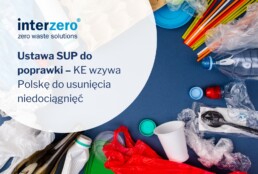
Newsletter
Limited scope of entities and inadequate calculation of fees are the main objections of the EC against the Polish SUP Act
In its letter of formal notice to Poland, the European Commission points to 2 key deficiencies that prejudge the non-compliance of the national law with the EU SUP Directive:
- Flawed definition of "producer"
The definition of 'producer' contained in the Polish Act of 14 April 2023 amending the Act on the obligations of entrepreneurs with regard to the management of certain waste and on the product fee, as well as some other acts, does not cover all activities performed by entities producing and marketing single-use products. As a consequence, the scope of application of the provisions on single-use plastic products is limited - not all entities that should fulfil producer obligations under the SUP Directive have been obliged to do so in the Polish act.
- Incomplete implementation of ROP for single-use plastic products
As the EC argues, the Polish legislation issued to transpose the SUP Directive does not ensure that waste generators properly calculate and bear all the costs of managing waste from single-use plastic products under extended producer responsibility schemes.
2 months to respond and remedy deficiencies
The failure to correctly transpose the directive on single-use plastic products (Directive (EU) 2019/904) gave rise to a letter of formal notice from the Commission. Poland has since had two months to respond and remedy the shortcomings identified by the Commission.
In the absence of a satisfactory response, the Commission may decide to issue a reasoned opinion.
This is not the first indication that the SUP Directive has not been correctly transposed
The June letter of formal notice is already another EC appeal to Poland in relation to the (non-)implementation of the provisions of the SUP Directive. As a reminder, the directive obliged all member states to bring into force the laws, regulations and administrative provisions necessary to implement the directive by 3 July 2021. The Polish SUP Act was not adopted until 14 April 2023. and came into force on 24 May 2023. For almost 2 years the Commission has been urging Poland to implement the provisions of the. Now the situation is repeating itself - although this time it is not the entire directive but only selected provisions, including the ROP provisions for selected single-use plastic products.
In accordance with the provisions of SUP, Member States had until 31 December 2024 to establish an extended producer responsibility scheme covering selected single-use plastic products. (for ROP systems established before 4 July 2018 and for tobacco products with filters and filters sold for use with tobacco products - until 5 January 2023). For the time being, this system is not functioning in Poland.
Read also: The SUP Directive, a half-whistle revolution - new Interzero report.
Source:
- Infringement proceedings: main decisions taken in June, https://ec.europa.eu/commission/presscorner/detail/pl/inf_25_1241
EC withdraws Green Claims Directive that was supposed to regulate green claims
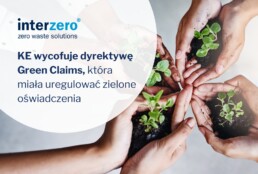
Newsletter
Green Claims Directive withdrawn, but with chance of return
Reports of the planned withdrawal of the draft directive began to appear in the media in the second half of June 2025. On Friday 20 June This information was officially confirmed by a Commission spokespersonMaciej Berestecki. The Commission's decision caused quite a stir among officials, but also among consumer and environmental organisations, which were surprised by such a sudden turn of events. All the more so as it was taken almost on the eve of the start of tripartite negotiations between the European Parliament, the EU Council and the Commission, aimed at reaching a common position on the legislative proposal.
Despite a clear statement from the EC, there are still chances to return to negotiations on the final content of the directive. The European Parliament and the current Presidency of the Council of the EU declare their readiness to resume the trialogue. One possible future scenario involves modifying the draft to be in line with the legislative vision and the Commission's mission.
No to an excessive burden of obligations on micro-entrepreneurs
As originally envisaged, The directive was intended to cover all businesses offering their products on the EU market. However, for micro-enterprises with fewer than 10 employees and an annual turnover of less than EUR 2 million, it provided for far-reaching simplifications in the substantiation of environmental claims. The purpose of applying these simplifications was to maintain the current level of competitiveness of the smallest companies against the global giants.
As the Commission emphasised, Avoiding excessive burdens (including financial burdens) for micro-entrepreneurs was one of the key objectives of the project Green Claims Directive. So significant, in fact, that departure from this premise prompted the EC to withdraw the draft in its entirety. In fact, during the legislative work in the European Parliament, provisions were introduced into the content of the directive extending the obligation of each independent verification of submitted environmental claims also to entities from the micro-enterprise sector. According to the EC, these changes were contrary to the Commission's policy of simplifying legislation and reducing the administrative burden for the smallest entities.
What was the Green Claims Directive supposed to be about?
The purpose of the Green Claims Directive was to setting the conditions for making environmental statements and to clarify the methods to be used by producers when substantiating their claims. It was also clear from the wording of the draft directive obligation for green claims to be subject to verification by an independent third party. However, the preamble of the draft mentions the need to exempt micro-entrepreneurs from strict requirements for substantiation and verification of environmental claims, which, according to the Commission, could generate a disproportionate administrative burden. It was this exemption, or rather the removal of this exemption, that became the bone of contention and the reason for the EC's withdrawal from further work on the draft directive.
It will be recalled that the original draft directive was presented by the EC in March 2023. The draft's explanatory memorandum cited a study finding that 53.3% of environmental statements "contains unclear, misleading or unfounded information on the environmental performance of products across the EU and across a range of product categories". Moreover, as many as 40% of such statements were unsubstantiated. As part of the verification of the conclusions of the cited study, the EU carried out a follow-up action, the results of which largely coincided with the findings of the study:
For more than half (57.5 %) of the 344 sustainability claims that were assessed, the authorities found that the trader did not provide sufficient elements to assess the veracity of the claim. In many cases, the authorities found it difficult to determine whether the claim related to the whole product or only one of its elements (50 %), whether it related to the company or only to some of the products (36 %) and which stage of the product life cycle it related to (75 %).
The Commission also indicated that the need to regulate pseudo green marketing was part of the overall actions envisaged in the New EU Action Plan and the Green Deal. The resulting changes from the Green Claims Directive were to promote more sustainable consumption contributing to the achievement of Sustainable Development Goal 12.6, which aims to encourage companies, particularly large and multinational companies, to implement sustainability practices and include information on this in their cyclical reports.
Is the withdrawal of the Green Claims Directive a green light for false green claims?
Abandonment of further legislative work on the Green Claims Directive does not mean that consumers will be completely deprived of protection against greenwashing. This will be provided by the ECGT Directive (or 'EmpCo' in English. Empowering Consumers for the Green transition) (Directive (EU) 2024/825 of the European Parliament and of the Council of 28 February 2024 amending Directives 2005/29/EC and 2011/83/EU as regards the empowerment of consumers in the ecological transition through better protection against unfair practices and better information and transparency), which is awaiting implementation in the legislation of EU Member States. The directive expands the scope of prohibited market practices to include greenwashing and prohibits the display of claims about the environmental performance of products that are not based on clear evidence or certification schemes.
Read more about the obligations imposed by the ECGT Directive and the potential impact of its implementation in the article: EU directives fight greenwashing. Is this the end of environmentalism?
Source:
https://eur-lex.europa.eu/legal-content/PL/TXT/?uri=CELEX:52023PC0166
